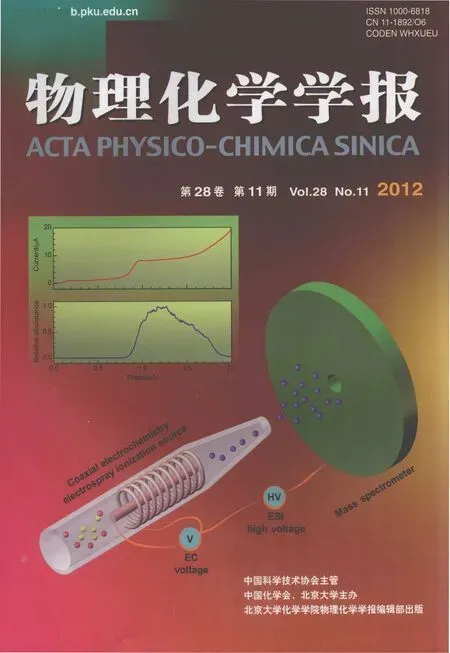同軸式電化學(xué)電噴霧質(zhì)譜離子源研究蒽電化學(xué)衍生十二胺
凌 星 丁傳凡
(復(fù)旦大學(xué)化學(xué)系,上海200433)
1 Introduction
Electrospray mass spectrometry is an indispensable tool for studying organic and biological samples.1It has been successfully integrated with other methods,such as liquid chromatography,2capillary electrophoresis,3and electrochemistry,to further enhance its capabilities.The coupling of electrochemistry with electrospray mass spectrometry(EC/ES-MS)is relatively new.Following its introduction by Zhou and Van Berkel in 1995,4EC/ES-MS has received increasing attention5-13because of its rapid determination of the molecular weights and structures of intermediates and products generated in electrochemical reactions,which are useful for elucidating the reaction mechanism.
Various kinds of probes have been proposed and used for online EC/ES-MS experiments.For example,tubular flowthrough probes are simple to construct by connecting two metal tubes,but the conversion efficiency is low and they are difficult to clean.4,14,15By contrast,porous flow-through probes offer high conversion efficiency because of their large surface areas, but they are also difficult to clean.4,16Recently,thin-layer flowby cells have become popular because of easy access to all the electrodes for cleaning.4,10,13,17,18However,potential measurements deviate considerably from those taken with a conventional cell,7and this could be attributed to the high solution resistance of the thin-layer electrolyte film.In addition,because of the extremely close spacing of the electrodes,reaction products generated at one electrode easily diffuse to the other.Such crosstalk is generally detrimental and may cause unwanted side reactions,reduce the conversion efficiency,and complicate the analysis.10,18This problem could be overcome using a divided cell,in which the counter electrode is isolated from the stream by a diaphragm.10,18A depolarizer could also be used,although this has not been attempted before in EC/ES-MS.The depolarizer is preferentially reduced/oxidized at the counter electrode,and this prevents interferences or undesired reactions.It also reduces the cell voltage and avoids the need for a divided cell.19
In this study,we introduce the coaxial probe as a new type of probe.A similar design was proposed in an earlier study,but the emphasis was on obtaining a fast response.5Compared to the earlier design,5the present probe uses a thicker platinum wire as the working electrode,a helix platinum wire as the counter electrode,a larger electrode separation,improved mechanical rigidity,and higher resistance to fouling.The probe was controlled by a wireless potentiostat floated at the electrospray high voltage.The performances of the probe,including hydrodynamic voltammetry,conversion efficiency,response time,and resistance to fouling were examined in detail.
A silver salt solution(10 mmol·L-1)in acetonitrile(MeCN) was used as the electrolyte and the depolarizer.The reagents studied here,including polyaromatic hydrocarbons and acyclic amines,are stable with Ag+in MeCN.Silver salts are commonly used in combination with a silver wire(or silver deposited on a passive substrate such as platinum)as the reference electrode and cathode in non-aqueous electrochemistry.20,21The silver-silver(I)couple is neither a strong oxidant nor strong reductant,which makes it stable,and it can be placed directly in the solution being examined.22-24Silver salts are effective depolarizers.20-22The reduction product of silver salt,silver,deposits on the counter electrode and does not react with the oxidation products generated at the working electrode.This enables use of a low cell voltage,which further reduces the possibility of undesired reductions at the counter electrode.
Online derivatization of anthracene(ANTH),which is a typical non-polar compound usually undetectable by ES-MS,with an acyclic amine,dodecylamine(DDA),was investigated here using the coaxial probe.Non-polar compounds with relatively stable radical cations,such as diphenylanthracene(DPA),have been detected by EC/ES-MS.5However,the radical cations of ANTH are very reactive,and this gives low signals or they are not detected.5For these compounds,the radical cations are usually consumed in fast chemical reactions with water,which is ubiquitous from the solution to the atmospheric sampling interface of the mass spectrometer.The reactions produce alcohols, aldehydes,and ketones,25which generally cannot be detected by ES-MS.By adding DDA into the solution as a derivatizing agent,the ANTH radical cation would react with DDA,which is a good nucleophile,to produce polar compounds that are detectable by ES-MS.EC/ES-MS has been successfully used to study pyridine addition to the DPA radical cation,6and benzene thiol and cysteine addition to oxidized dopamine.7The derivatization studied here may provide new insights into the complex anodic oxidation ofANTH.21,26-29
2 Experimental
2.1 Coaxial probe
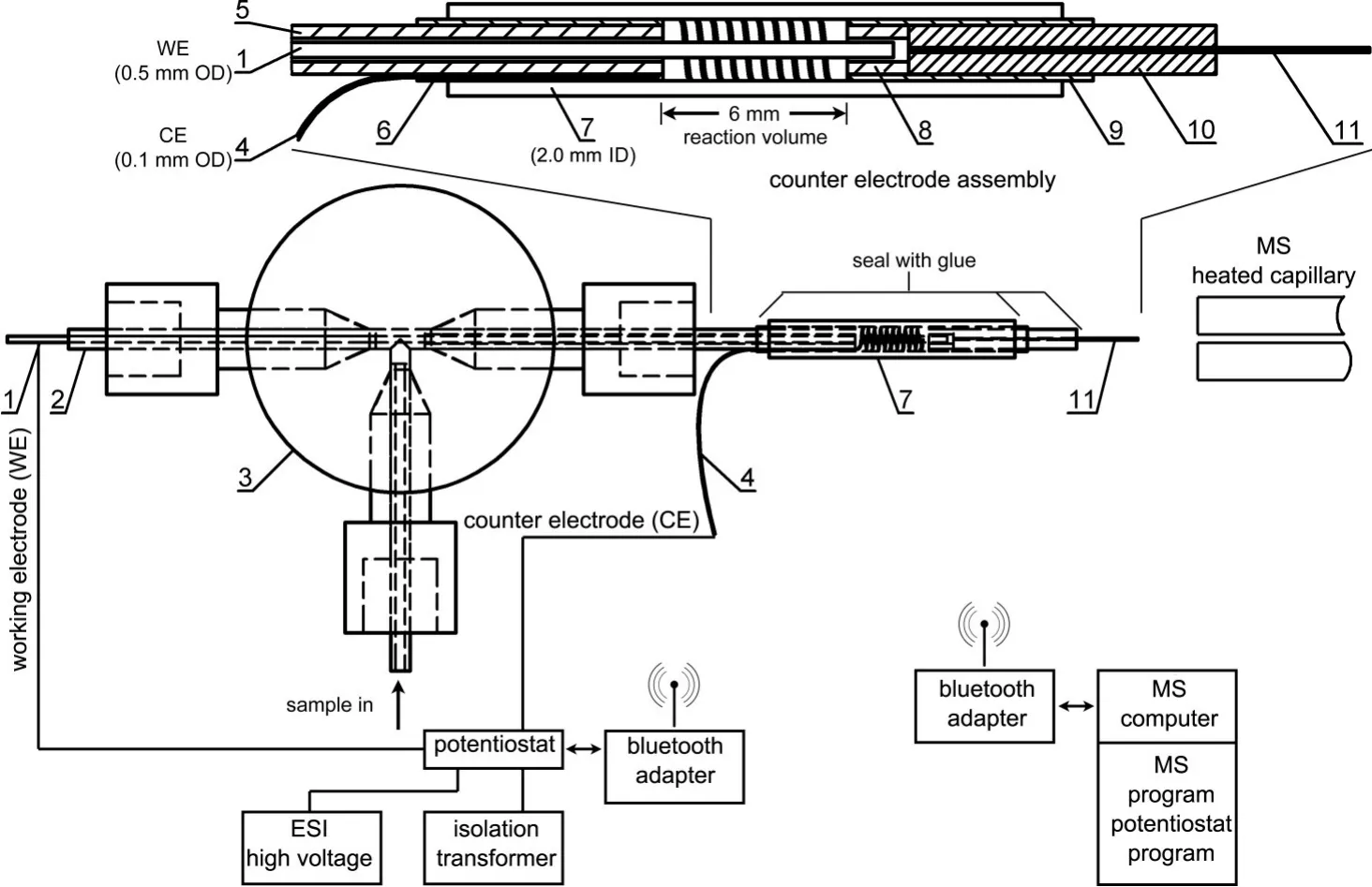
Fig.1 EC/ES-MS setup showing the coaxial probe and detail view of the counter electrode assemblyMaterials for building the coaxial probe are listed in Table 1.See text for detailed explanation.

Table 1 List of materials for constructing the coaxial probe
The coaxial probe included a working and counter electrode (Fig.1).The materials used to construct it are listed in Table 1. All the materials are commercially available and inexpensive. The working electrode was made from a polyetheretherketone (PEEK)(IDEX Health&Science LLC,Oak Harbor,WA)tube with a T-joint(No.3 in Fig.1,Scientific Instrument Services, Inc.,West Palm Beach,FL)and a platinum wire(No.1 in Fig.1,Φ 0.5 mm,Sinopharm Chemical Reagent Co,Ltd., Shanghai,China).The counter electrode was assembled from PEEK and polytetrafluoroethylene(PTFE)tubes cut into appropriate sizes,and a platinum wire(No.4 in Fig.1,? 0.1 mm, Sinopharm Chemical Reagent Co,Ltd.)as the counter electrode.One end of wire 4(70 mm long)was wound around a cylinder(? 1.6 mm)to form a spiral.The spiral end was housed in tube(No.7 in Fig.1,I.D.2.0 mm).The other end was left exposed as an electrical lead,from which the potential was applied.The working electrode was supported at each end by two tubes(Nos.5 and 8 in Fig.1)with a separation distance of 6 mm.These tubes limited the surface area of the electrodes exposed to the solution.For the working electrode,the area was 9.42 mm2(A1).For the helical counter electrode,the area is 22.6 mm2(A2),assuming a helix pitch of 0.50 mm and a helix radius of 0.95 mm.The inside volume of the probe bound by the same two tubes(Nos.5 and 8 in Fig.1)is referred to as the reaction volume,V,where the electrochemical reaction primarily occurs,and was estimated to be 17.1 μL.The average distance between the electrodes,d,was 0.7 mm.
One counter electrode took approximately 5 min to assemble.A new counter electrode was prepared for each reagent. No hazardous chemicals were required for cleaning the working electrode assembly.After removal from the assembly,the platinum wire(No.1 in Fig.1)was polished with alumina powder,dipped into dilute nitrate acid,and finally rinsed with water and dried under N2.After reassembly,the probe was thoroughly rinsed with MeCN.For experiments using amines,the syringe and transfer line were flushed successively with water containing 1%acetic acid,water,methanol,and MeCN.
Reagents were prepared in acetonitrile containing~10 mmol·L-1AgClO4as the electrolyte.Caution:silver perchlorates are potentially explosive and should be handled with the necessary precautions.Silver perchlorate was used for convenience.However,other safe silver salts,such as silver triflate or silver trifluoroacetate,are recommended.Reduction of Ag+to Ag at the counter electrode was used to gauge the oxidation potential of the reagent at the working electrode(vs Ag/10 mmol·L-1Ag+).In the two-electrode configuration,the potential drop across the solution always presented as an error in the potential control.For a coaxial probe filled with 10 mmol·L-1AgClO4/ MeCN,the AC impedance was measured 250 Ω using a 10 mV peak-to-peak sinusoidal input signal with a frequency of 1 kHz.
2.2 Wireless potentiostat
A wireless potentiostat30floated at the electrospray high voltage(2.5 kV)was used to apply the potential to the coaxial probe and measure the current flowing through it(Fig.1).The accuracy of potential control was±1 mV in a potential range of-2.5 to 2.5 V,and the accuracy of the current measurement was±0.1 μA.The potentiostat worked in a two-electrode configuration with the coaxial probe.
2.3 Mass spectrometry and online EC/ES-MS
An ion-trap mass spectrometer(LCQ Classic,Thermo Fisher Scientific Inc.,Waltham,MA)was used to detect the ions generated by the coaxial probe during the electrospray process. The coaxial probe was mounted on a customized scaffold with its tip facing a heated capillary(200°C)at a distance of approximately 1.5 cm.The probe tip was offset horizontally from the capillary hole by 0.5 cm.The ion injection time was 10 ms. The other parameters were the default settings for the instrument.MS/MS was performed with helium as the buffer gas. The mass spectrometer?s control program was running on the same computer as the program controlling the potentiostat,and the computer clock was used to synchronize the data captured by the two programs.
To perform hydrodynamic voltammetry and online EC/ESMS,the sample solution was pumped continuously into the coaxial probe at the desired flow rate using the syringe pump of the LCQ mass spectrometer.Once the probe was full,a predefined potential waveform was applied.For online EC/ ES-MS,the mass spectra were recorded simultaneously.
2.4 Reagents
High-performance liquid chromatography grade MeCN and methanol were obtained from Merck(Darmstadt,Germany). Water was double distilled.Anhydrous silver perchlorate, ANTH(99%)and 9,10-diphenylanthracene(99%)were purchased from Alfa Aesar(Ward Hill,MA).All other reagents were of analytical grade(Sinopharm Chemical Reagent Co, Ltd.)and used as received.
3 Results and discussion
3.1 Hydrodynamic voltammograms of DPA
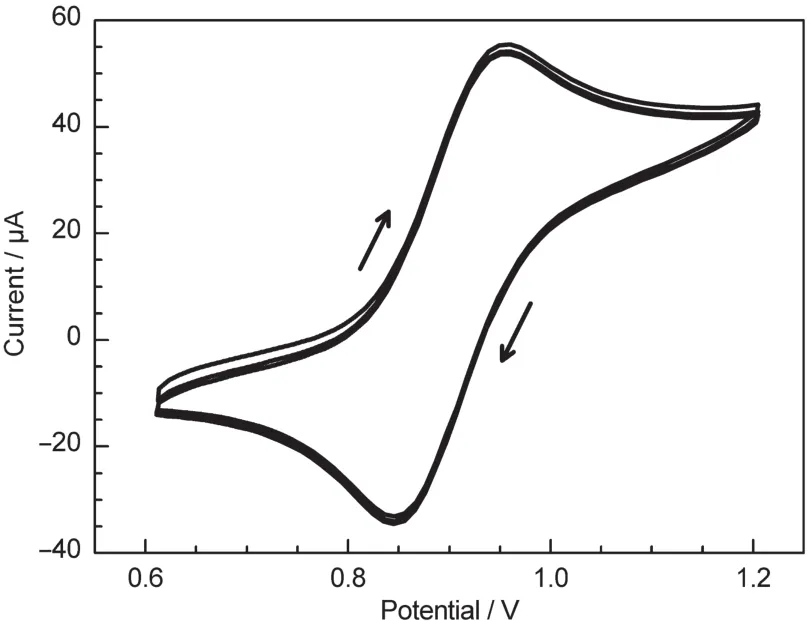
Fig.2 Hydrodynamic voltammograms(three cycles)of 1 mmol· L-1DPA/10 mmol·L-1AgClO4/MeCNsweep rate:0.1 V·s-1;flow rate:12 μL·min-1
DPA has well-defined electrochemical behavior in MeCN,5,31-33and was used to characterize the performance of the coaxial probe.The oxidation and reduction peaks in the measured hydrodynamic voltammograms were symmetrical(Fig.2).The half-wave potential E1/2was calculated as 0.903 V from the anodic and cathodic peak potentials using the formula(Epa+Epc)/2. After adding the reference electrode potential of 0.29 V for Ag/ 10 mmol·L-1Ag+(vs SCE),24the result is very close to the reported value obtained with cyclic voltammetry in a three-electrode configuration.31The hydrodynamic voltammograms measured by other EC/ES-MS probes usually exhibit relatively large deviations from the cyclic voltammograms.4,14,15,34However,a close agreement is found here,which could be attributed to the coaxial design of the probe and the use of 10 mmol·L-1AgClO4as the electrolyte and depolarizer.The solution resistance was measured to be 250 Ω,which produced an error in the potential measurement of<25 mV for a peak current ipof<0.1 mA.The low solution resistance was further confirmed by a calculation using the formula R=2d/Λ(A1+A2),where A1,A2are the active surface areas and d is the separation distance of the electrodes.Using the dimensions given in Table 1 and a reported molar conductivity of Λ=170 S·cm2·mol-1for 10 mmol· L-1AgClO4/MeCN,35the solution resistance R was calculated as 257 Ω.
3.2 Conversion efficiency
The conversion efficiency for the coaxial probe is defined as ΔC/C,where C is the initial reagent concentration entering the probe and ΔC is the decrease in the reagent concentration after leaving the probe.The conversion efficiency is characterized as a function of flow rate by performing a constant potential electrolysis of triethylamine in MeCN(n≈1).The oxidation potential was 1.2 V,23which is approximately 0.3 V higher than the Epaof triethylamine(Fig.S1,see Supporting Information). ΔC was estimated from the measured electrochemical current using the formula ΔC=i/nFv,36where i is the steady-state electrochemical current(about 5 min after a flow rate change),F is Faraday?s constant,v is the volumetric flow rate,and n is equal to one.The background current was verified as<0.5 μA using a blank solution containing only 10 mmol·L-1AgClO4(1.2 V, 3.6 μL·min-1).The conversion efficiency decreased with the flow rate(Fig.3),and was 77%at the flow rate commonly used for online experiments(3.6 μL·min-1).This conversion efficiency is lower than that of thin-layer and porous cells,7,10,37but much higher than that of tubular cells.4,14,15,34This is expected with the coaxial design because the distance between the electrode is minimized and their overlap is maximized.5
3.3 Response time and resistance to fouling
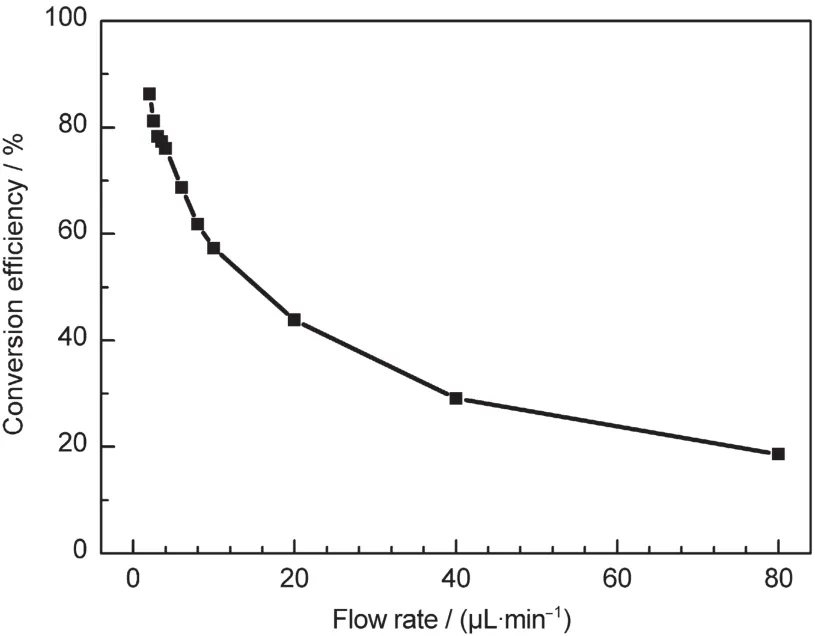
Fig.3 Electrochemical conversion efficiency as a function of flow rate determined for 2 mmol·L-1triethylamine/8 mmol·L-1 AgClO4/MeCN at constant potential(1.2 V)electrolysis
The EC/ES-MS response time is defined as the time between the application of potential to the probe and appearance of a mass spectral signal corresponding to an electrogenerated product ion.5The response time was characterized from an online EC/ES-MS potential step experiment using DPA,30and was as low as 5 s at 3.6 μL·min-1.The estimated dead volume from the end of the working electrode to the probe exit was 0.25 μL.This produced a response time of 4.2 s at 3.6 μL· min-1,which corresponded with the measured value.
Because Ag+acted as a depolarizer and was preferentially reduced on the counter electrode,continuous deposition of silver was found during the experiments.This could cause serious problems by plugging up the probe and shorting the circuit. Nevertheless,probe failure was not observed in the use of more than 30 different counter electrode assemblies.For each assembly,different kinds of reagents,such as polyaromatic hydrocarbons,and acyclic and aromatic amines,were tested.The reagent concentrations were up to 2 mmol·L-1and the solutions were continuously pumped through the probe for at least 3 h at 3.6 μL·min-1with the electrochemical voltage turned on. For example,a constant potential electrolysis of 2 mmol·L-1aniline at 3.6 μL·min-1was continuously operated for 1 h. Even though extensive polymerization of aniline was evident from the dark color of the drops leaving the probe,the electrochemical current stabilized at approximately 12 μA(Fig.S2, see Supporting Information).The process was not interrupted by the insoluble polyaniline or the silver deposited on the counter electrode.The high resistance to fouling for the coaxial probe could be attributed to the relatively large electrode separation(0.7 mm).However,prolonged use of this probe beyond these conditions inevitably led to over-deposition of silver on the counter electrode.When this occurred,a new counter electrode assembly was constructed quickly and inexpensively. Cleaning of the assembly was as effective as for other tubular and porous flow-through cells,especially considering that it was made of platinum and chemically resistant plastics.In addition,the silver deposited on the counter electrode could be reoxidized and transferred to the working electrode by applying a small negative potential(e.g.,-0.5 V)to the working electrode,which was then easily cleaned.The thicker working electrode used here could be mechanically polished,which is a very effective cleaning method for electrodes.Mechanical polishing could not be used with earlier probe designs because they used thin and fragile platinum wires.5,6
The earlier design used a solid stainless steel tube as the counter electrode,5,6and this was replaced by a helical platinum wire in the present study.This provided the following benefits: platinum is a stable and inert electrode material that is more widely used than stainless steel;the probe interior is visible, which enables real-time observation of the electrode conditions;and platinum wire(Φ 0.1 mm)is much cheaper than a solid platinum tube,which is difficult to find in suitable sizes.
3.4 Online derivatization of ANTH with DDA
Online derivatization by EC/ES-MS was demonstrated using ANTH and DDA.DDA has a long aliphatic tail and a strong propensity to form gas phase ions,which enhances detection of its derivatization products.Hydrodynamic voltammograms of ANTH,DDA,and their mixture are given in Fig.4.The oxidation wave of DDA shows a small slope with the peak drawn out over a large potential range that is characteristic for primary amines.38,39Electrografting of a primary amine to the platinum surface formed an organic monolayer,which slowed electron transfer.39However,the oxidation peak of ANTH appears unaffected by the presence of DDA.
Because DDA oxidizes at a potential close to that of ANTH, the oxidation products of DDA would coexist with that of ANTH.To distinguish them,a separate online EC/ES-MS investigation of DDA alone was performed.The primary oxidation product was identified as a Schiff base XIV(C11H23―CH=N―C12H25,MW=351),which formed mono-(m/z 458/460)and bis-complexes(m/z 809/811)with Ag+(Fig.S3,see Supporting Information).When the potential increased and more protons were released into the solution,the product was detected in protonated form(m/z 352).
An online EC/ES-MS investigation of the ANTH-DDA mixture was performed with a linear potential sweep to study the product distribution as a function of potential.Representative mass spectra captured at different potentials are shown in Fig.5.The corresponding current and ion abundance vs potential profiles are given in Fig.6.
At 0 V,Fig.5(a)shows characteristic peaks of the Ag+-DDA complexes(also see Fig.S3)in addition to that of the Ag+-MeCN complexes(m/z 189/191).30,40A mixed-ligand complex of[Ag(DDA)(MeCN)]+(m/z 333/335)was also observed.
At 1.2 V,above the oxidation potential of ANTH,Fig.5(b) shows new peaks at m/z 863/865 with intensities five times that of[Ag(MeCN)2]+,and a cluster of peaks centered around m/z 486 with relatively low intensity.The Schiff base XIV was not observed in noticeable abundance in Fig.5(b),which suggests a reaction occurred between the ANTH oxidation product and DDA,and this interrupted oxidation of DDA itself(Fig.6 (e)).
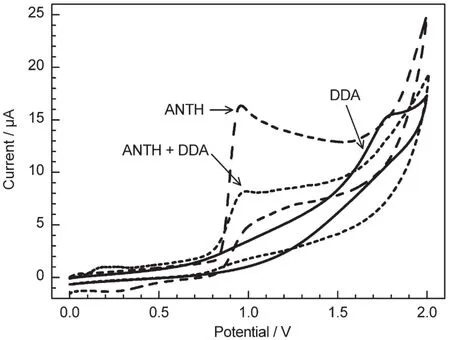
Fig.4 Hydrodynamic voltammograms of 0.32 mmol·L-1ANTH/ 10 mmol·L-1AgClO4/MeCN,2 mmol·L-1DDA/8 mmol·L-1 AgClO4/MeCN,and 0.16 mmol·L-1ANTH/1 mmol·L-1DDA/ 9 mmol·L-1AgClO4/MeCN.sweep rate:4 mV·s-1;flow rate:3.6 μL·min-1
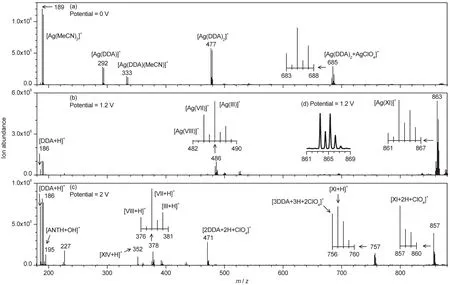
Fig.5 Mass spectra(single scan with a micro scan count of five)captured at(a)0 V,(b)1.2 V,and(c)2 V during an online EC/ES-MS linear sweep experiment of 0.16 mmol·L-1ANTH/1 mmol·L-1DDA/9 mmol·L-1AgClO4/MeCN from 0 to 2 Vsweep rate:4 mV·s-1;flow rate:3.6 μL·min-1.Shown as an inset in(b)is(d),a zoom scan(averaged from 24 scans)obtained with the same probe and solution but at a constant potential of 1.2 V.
From the characteristic isotopic distribution,the peaks at m/z 863/865 appear to be a complex between Ag+and the newly formed compounds.MS/MS showed fragment ions at m/z 484, 486,and 488,which overlapped with the cluster of peaks centered at m/z 486.This suggests that the peaks might be associated with a mixed-ligand complex between Ag+and two ligands with MWvalues of 377(L1)and 379(L2).However,this assumption does not account for the following observations.(1)The peak intensities measured at m/z 861 and 867 were too small. Taking into account the isotopic distribution of Ag+and ligands,the peak intensities of the ion[107Ag(L1)2]+at m/z 861 and[109Ag(L2)2]+at 867 would be 32%and 46%of that at m/z 863,respectively.These values are significantly larger than the measured values of 18%and 8%.(2)The peak intensity at m/z 861 decreased to nearly zero(Fig.5(d))in another experiment at a constant potential of 1.2 V.Therefore,the ion species at m/ z 863/865 must primarily,if not exclusively,be a mono-complex between Ag+and a newly formed compound with a MWof 756.
By sweeping the potential up to 2 V with more protons released into solution,the compound was detected in the protonated form with m/z 757(Fig.5(c)).It should be noted that the intensity measured at m/z 757 includes the isotopic contribution from the ion[3DDA+3H+2ClO4]+(m/z 756)(see also Fig. S3).MS/MS showed the m/z 857 ion was an adduct of the m/z 757 ion with HClO4.Peaks at m/z 376,378,and 380 were assigned to compounds with MWvalues of 375,377,and 379 in protonated forms,respectively.These compounds appeared in Fig.5(b)at m/z 482,484,and 486 as mono-complexes with Ag+.Competition between Ag+and H+for these compounds was obvious in the ion abundance vs potential profiles(Fig.6).
An ion at m/z 195 was also observed in low abundance (Figs.5(c)and 6(b))with the onset of ANTH oxidation,and was assigned to an addition product of the ANTH radical cation with H2O.This was confirmed by MS/MS(fragment ion at m/z 177 by loss of H2O).The other peaks in Fig.5(c)are related to DDA and the Schiff base XIV.At higher potential(1.7 V), close to the oxidation peak of DDA in Fig.4,the DDA oxidation was slightly enhanced as indicated by the increase in abundance of XIV(Fig.6(e)).The slow oxidation of DDA on a platinum electrode effectively protected it from being consumed before the oxidation of ANTH,which is important for its use as a derivatizing agent.
A reaction pathway that produces the observed compounds with MWvalues of 375,377,379,and 756 is proposed in Scheme 1 based on the knowledge of anodic oxidation of ANTH.21,26-29First,one electron was removed from ANTH to generate the ANTH radical cation I,which could react with H2O,followed by the loss of a proton and an electron,to pro-duce the observed cation II with a MWof 195.I could also react with DDA in a similar way to produce another potential intermediate XII(Scheme S1,see Supporting Information).Although DDA is a better nucleophile than H2O,its reaction with I appears unlikely,since neither XII nor its following product, such as XIII(Scheme S1),were abundant in the MS results. This is most probably because of the relatively low concentration of DDA(1 mmol·L-1)compared to that of H2O(>30 mmol·L-1)commonly found in MeCN.Similarly,II could react with H2O to form 9,10-dihydroxy-9,10-dihydroanthracene, which was not detectable by ES-MS,or with DDA to form the observed compound III(MW=379).Instead of reacting with nucleophiles,II could also deprotonate to form the 9-anthranol V, which is probably an important intermediate in the anodic oxidation of ANTH in MeCN.21,26,28V was easier to oxidize than ANTH.After losing an electron to the electrode,it generated the radical cation VI.VI could react with H2O,followed by further oxidation,to form anthraquinone,which was not detectable by ES-MS,or with DDA to form the observed compound VII(MW=377).Notably,oxidation of III also gave compound IV(MW=377),which is a tautomer of VII.Further oxidation of VII led to VIII(MW=375).Because of the stabilizing effect of the substituted hydroxyl group,VI(or IX by tautomerization) could behave like a radical and form the dication X.X could react with H2O to give bianthrone,or react with DDA followed by the loss of two protons to generate the observed compound XI(10,10?-bis(dodecylamino)-10,10?-dihydroxy-9,9?,10,10?-tetrahydro-9,9?-bianthryl,MW=756).Compound XI,which is acarbinolamine intermediate in Schiff base/imine hydrolysis that readily undergoes elimination to form bianthrone,was probably stabilized by complexation with Ag+,41which would contribute to the large abundance observed in Fig.5(b).
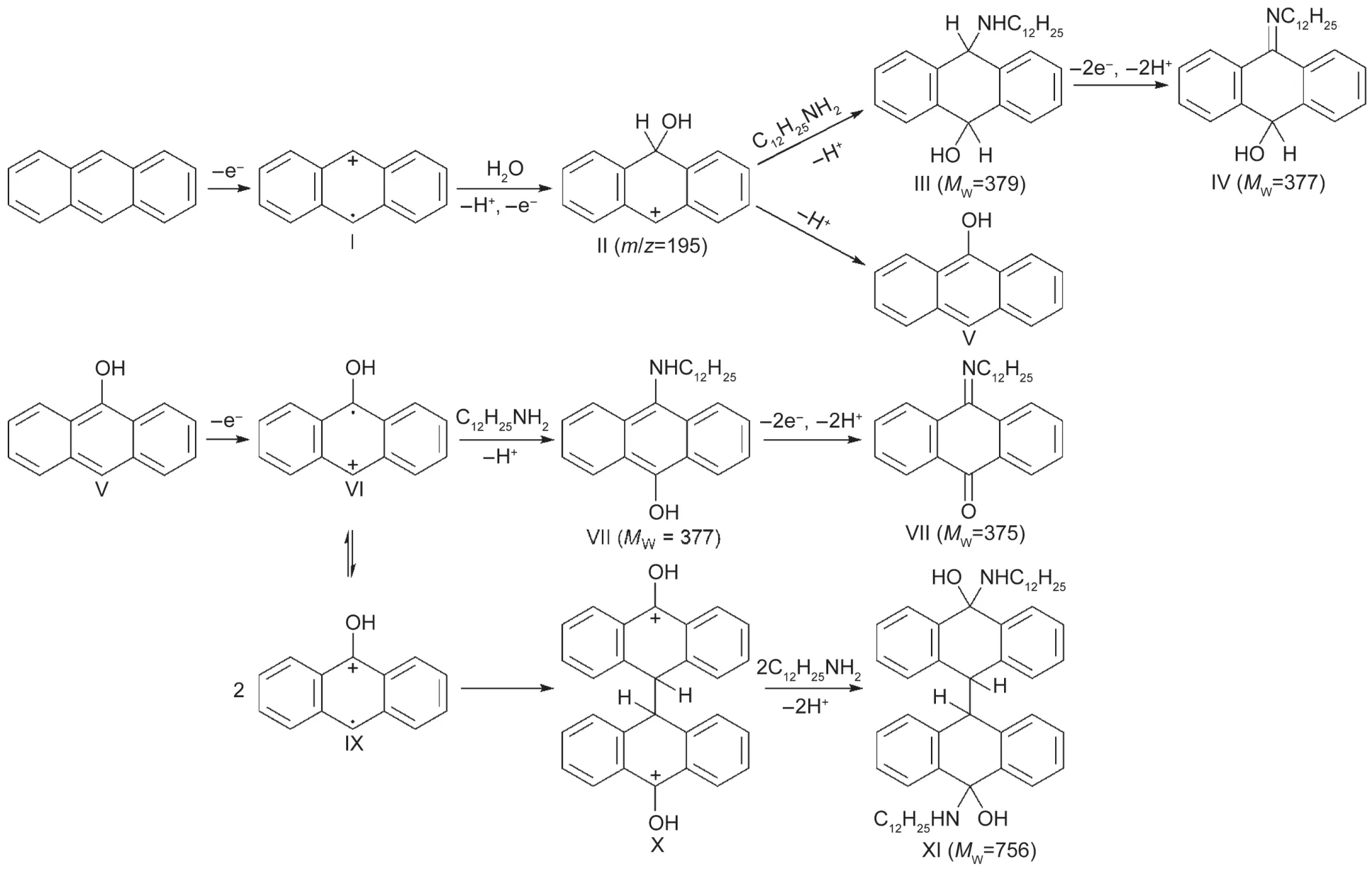
Scheme 1 Pathways of electrochemical derivatization of anthracene with dodecylamine
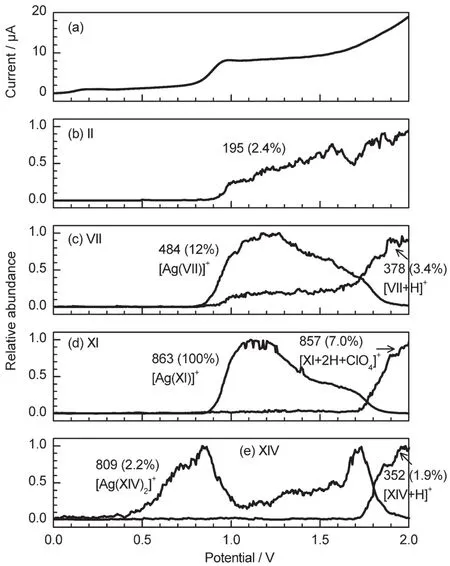
Fig.6 (a)Current and(b-e)ion abundance vs potential profiles obtained during the same experiment described in Fig.5Each profile was normalized to the maximum intensity of that respective ion, which is displayed in parentheses to the right of m/z,as a percentage of that of the m/z 863 ion(d).
4 Conclusions
The coaxial probe is well suited for online EC/ES-MS,and has the following characteristics:(1)it is simple to construct/ assemble in minutes using readily-available,inexpensive materials;(2)it has a low response time of 5 s at 3.6 μL·min-1that can be reduced by increasing the flow rate or minimizing the dead volume;(3)it provides a conversion efficiency for triethylamine of 77%at 3.6 μL·min-1,and this can be increased by increasing the probe length or reducing the probe radius(i.e., the distance between the electrodes);and(4)it is resistant to fouling with relatively large electrode separation.
Online electrochemical derivatization of ANTH with DDA led to immediate observation of numerous polar compounds by ES-MS.Traditional methods for studying organic electrochemistry21,25-29usually require large quantities of solvents,electrolytes and reagents,and time-consuming preparation,extraction,purification,and identification processes.By comparison, the present method using online EC/ES-MS is much simpler, and quantitative information about the molecular weights and structures of intermediates and products is obtained in seconds.
Supporting Information: available free of charge via the internet at http://www.whxb.pku.edu.cn.
(1) Crain,P.F.Electrospray Ionization Mass Spectrometry of NucleicAcids and Their Constituents,In Electrospray Ionization Mass Spectrometry;Cole,R.B.Ed.;Wiley:New York,1997,p 421.
(2) Voyksner,R.D.Combining Liquid Chromatography with Electrospray Mass Spectrometry,In Electrospray Ionization Mass Spectrometry;Cole,R.B.Ed.;Wiley:New York,1997, p 323.
(3) Severs,J.C.;Smith,R.D.Capillary Electrophoresis: Electrospray Ionization Mass Spectrometry,In Electrospray Ionization Mass Spectrometry;Cole,R.B.Ed.;Wiley:New York,1997,p 343.
(4) Zhou,F.M.;Van Berkel,G.J.Anal.Chem.1995,67,3643.doi: 10.1021/ac00116a005
(5)Xu,X.M.;Lu,W.Z.;Cole,R.B.Anal.Chem.1996,68,4244. doi:10.1021/ac960362i
(6)Lu,W.Z.;Xu,X.M.;Cole,R.B.Anal.Chem.1997,69,2478. doi:10.1021/ac9612842
(7) Deng,H.T.;Van Berkel,G.J.Electroanalysis 1999,11,857. doi:10.1002/(SICI)1521-4109(199908)11:12<857::AIDELAN857>3.0.CO;2-1
(8) Diehl,G.;Karst,U.Anal.Bioanal.Chem.2002,373,390.doi: 10.1007/s00216-002-1281-3
(9) Karst,U.Angew.Chem.Int.Edit.2004,43,2476.doi:10.1002/ anie.200301763
(10) Zettersten,C.;Lomoth,R.;Hammarstrom,L.;Sjoberg,P.J.R.; Nyholm,L.J.Electroanal.Chem.2006,590,90.doi:10.1016/ j.jelechem.2006.02.028
(11) Van Berkel,G.J.;Kertesz,V.Anal.Chem.2007,79,5510.doi: 10.1021/ac071944a
(12) Permentier,H.P.;Bruins,A.P.;Bischoff,R.Mini-Rev.Med. Chem.2008,8,46.doi:10.2174/138955708783331586
(13) Zettersten,C.;Sjoberg,P.J.R.;Nyholm,L.Anal.Chem.2009, 81,5180.doi:10.1021/ac802563f
(14) Bond,A.M.;Colton,R.;Dagostino,A.;Downard,A.J.; Traeger,J.C.Anal.Chem.1995,67,1691.doi:10.1021/ ac00106a007
(15) Zhang,T.Y.;Palii,S.P.;Eyler,J.R.;Brajter-Toth,A.Anal. Chem.2002,74,1097.doi:10.1021/ac015543l
(16) Hayen,H.;Karst,U.Anal.Chem.2003,75,4833.doi:10.1021/ ac0346050
(17) Deng,H.T.;Van Berkel,G.J.Anal.Chem.1999,71,4284. doi:10.1021/ac990527y
(18) Bokman,C.F.;Zettersten,C.;Sjoberg,P.J.R.;Nyholm,L. Anal.Chem.2004,76,2017.doi:10.1021/ac030388r
(19) Yoshida,K.Electrooxidation in Organic Chemistry;Wiley:New York,1984.
(20) Friend,K.E.;Ohnesorge,W.E.J.Org.Chem.1963,28,2435. doi:10.1021/jo01044a502
(21) Majeski,E.J.;Stuart,J.D.;Ohnesorg,W.J.Am.Chem.Soc. 1968,90,633.doi:10.1021/ja01005a013
(22) Loveland,J.W.;Dimeler,G.R.Anal.Chem.1961,33,1196. doi:10.1021/ac60177a022
(23) Smith,P.J.;Mann,C.K.J.Org.Chem.1969,34,1821. doi:10.1021/jo01258a063
(24) Mann,C.K.;Barnes,K.K.Electrochemical Reactions in Nonaqueous Systems;Marcel Dekker:New York,1970.
(25) Organic Electrochemistry,4th ed.;Lund,H.,Hammerich,O. Eds.;Marcel Dekker:New York,2001.
(26) Parker,V.D.Acta Chim.Scand.1970,24,2757.doi:10.3891/ acta.chem.scand.24-2757
(27) Parker,V.D.Acta Chim.Scand.1970,24,3151.doi:10.3891/ acta.chem.scand.24-3151
(28) Parker,V.D.Acta Chim.Scand.1970,24,3162.doi:10.3891/ acta.chem.scand.24-3162
(29) Parker,V.D.Accounts Chem.Res.1984,17,243.doi:10.1021/ ar00103a004
(30) (a)Ling,X.;Ding,C.F.Chin.J.Anal.Chem.2012,accepted. [凌 星,丁傳凡.分析化學(xué),2012,40(10)] (b)Ling,X.;Ding,C.F.Coaxial Probe for Online Electrochemistry/Electrospray Mass Spectrometry,In Instrumentation:New Developments in Ionization and Sampling II,Proceedings of the 60thASMS Conference on Mass Spectrometry andAllied Topics,Vancouver,Canada,May 20-24,2012;ASMS:Santa Fe,NM,2012.
(31) Sioda,R.E.J.Phys.Chem.1968,72,2322.doi:10.1021/ j100853a007
(32)Howell,J.O.;Wightman,R.M.J.Phys.Chem.1984,88,3915. doi:10.1021/j150662a001
(33) Hammerich,O.;Parker,V.D.Advances in Physical Organic Chemistry 1984,20,55.doi:10.1016/S0065-3160(08)60148-3
(34) Mautjana,N.A.;Estes,J.;Eyler,J.R.;Brajter-Toth,A. Electroanalysis 2008,20,1959.doi:10.1002/elan.v20:18
(35) Yeager,H.L.;Kratochv.B.J.Phys.Chem.1969,73,1963. doi:10.1021/j100726a053
(36) Bard,A.J.;Faulkner,L.R.Electrochemical Methods;2nd ed.; Wiley:New York,2001.
(37) Kertesz,V.;Van Berkel,G.J.;Granger,M.C.Anal.Chem. 2005,77,4366.doi:10.1021/ac0503411
(38) Mann,C.K.Anal.Chem.1964,36,2424.doi:10.1021/ ac60219a014
(39) Adenier,A.;Chehimi,M.M.;Gallardo,I.;Pinson,J.;Vila,N. Langmuir 2004,20,8243.doi:10.1021/la049194c
(40) Henderson,W.;McIndoe,J.S.Mass Spectrometry of Inorganic, Coordination,and Organometallic Compounds;Wiley: Chichester,2005.
(41) Suh,J.;Min,D.W.J.Org.Chem.1991,56,5710.doi:10.1021/ jo00019a048

